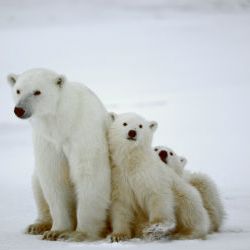Polar Bears In Southern Greenland

Polar bears are being found in territory not thought suitable to sustain their needs. Southern Greenland was not an area thought to be habitable by polar bears but yet there they are.
Polar bears are excellent swimmers but are land animals. They are ambush predators, feeding on marine life. They accomplish that by attacking prey such as seals when they come up for air at holes in the sea ice.
Adapt to survive
In southern Greenland this technique is virtually redundant. The sea ice season is less than four months long, so the bears have to adapt to survive to be in this habitat.
New research has studied DNA of polar bears in southern Greenland and it found that the few hundred bears that live here year round are different enough to be considered a subpopulation.
Knowing that these bears are having to adapt their hunting skills beyond the sea ice could make us believe that polar bears are more resilient to climate change than we thought.
Subspecies
The DNA research discovered that the southern Greenland subspecies didn’t mingle with northern populations. The more northern bears travel for miles on sheets of sea ice, whereas the southern bears stay close to shore in a series of fjords, not roaming nearly as far.
The research has highlighted that within the fjords where there is glacial ice flows for the bears to hunt within. That has led the researchers to think there may be other areas that will similarly suit polar bears. However, these habitats are uncommon in the Arctic and wouldn’t support many bears. So, while some polar bears have adapted to survive habitat change due to shifts in climate, we cannot expect that to be the case for the entire population.
If you would like to find out more about supporting polar bear conservation, please visit our Adopt a Polar Bear page.



